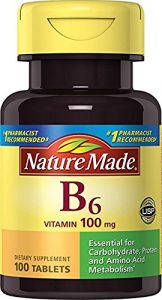76 8.6 Vitamin B6, the Potential Treatment for People with ASD
What contributed to this discovery?
In the 2000s, microbiota became one of the most popular fields of study due to its promising evidence which suggests the potential it has in regulating our normal body functions and preventing bacterial infections. Many studies have proven that gut microbiota dysbiosis (the imbalance of bacterial diversity caused by the disruption of the gut microbiota) led to the colonization of Clostridium difficile (a sporulated bacteria) resulting in persistent infections. In recent decades, more and more researchers shifted their interest towards the effects of microbiota dysbiosis and were particularly interested in the relationship it has with the brain. Researchers have quoted this relationship between the gut microbiota and the brain as the gut-brain axis. Recent studies have linked microbiota dysbiosis with neural related disorders such as ASD stating that dysbiosis of the gut reduces the production of vitamin B6 causing reduced levels of dopamine release resulting in ASD-like social deficits (Li et al., 2020). These studies have highlighted the possibilities of using vitamin B6 as a method of treatment for people with ASD.
How does vitamin B6 control dopamine release?
Vitamin B6 can be found in a variety of foods in our daily diets. In addition to foods, it also comes in the form of a supplement. However, research has also suggested that vitamin B6 can also be produced by the bacteria in our guts (Li et al., 2020). Vitamin B6 takes part in multiple metabolic pathways and functions to regulate the nervous system. Despite the many roles that they play, our focus will be their ability to produce neurotransmitters and myelinated axons since it contributes to the elevation of dopamine levels. Here we will further discuss the mechanism between vitamin B6 and the release of dopamine. Vitamin B6’s ability to control axon myelination and neurotransmitter production further suggests its role in regulating the release of dopamine where deficiency leads to social and behavioral deficits (Kirksey, Morré, & Wasynczuk, 1990). The increased myelination of axons functions to accelerate the conduction of the neurotransmitters along the axon since conduction occurs more efficiently. In addition, the increased rate of conduction determines the levels of dopamine being released. To further support the importance of myelination in neurotransmitter release, another study further investigated this relationship with the use of phenylketonuric mice. Phenylketonuric mice were used since they exhibited hypomyelination and reduced levels of dopamine where individuals with phenylketonuria exhibit similar ASD-like symptoms (Targum & Lang, 2010). To observe whether hypomyelination contributes to the reduction of dopamine release, phenylketonuria mice were given a low phenylketonuric diet for several days and were able to observe a decrease in the phenylketonuric levels (Joseph & Dyer, 2003). The reduced phenylketonuric levels contributed to an increase in dopamine levels which is most likely influenced by the increase of myelinated axons (Joseph & Dyer, 2003). The results of this study concluded the potential association that increased axon myelination could contribute to an increase in dopamine release. Studies concluded that Vitamin B6 produced in the microbiota is needed for the production of dopamine and axon myelination which helps with the release of dopamine leading to neural regulation.
The pros and cons of using vitamin B6
The results obtained from both studies suggested the importance of Vitamin B6 for adequate dopamine release. This states that vitamin B6 has great potential to be incorporated as a treatment for people with ASD. This idea is very promising because vitamin B6 can be obtained through the consumption of meat products such as salmon and beef (Whelan, 2017). However, vegetarians don’t have to worry about not obtaining enough vitamin B6 since it can also be obtained through plant-based products such as soybeans, oats, and bananas. In addition to food, vitamin B6 can be found in the form of a supplement making it highly accessible. If increased intake of vitamin B6 could really alleviate the ASD symptoms, then it marks the use of a drug-free treatment for targeting the social deficits exhibited in ASD patients. The use of a drug-free treatment can greatly benefit children since, despite drugs being approved for child use, the side effects could influence their ability to perform daily activities. Knowing the importance of early interventions for ASD treatments, the use of vitamin B6 can potentially maximize the alleviations while minimizing the adverse effects that ASD treatments could have on children.
 .
. 
Despite the wonders of vitamin B6 stated above, everything has its advantages and disadvantages. Here, we will discuss, investigate, and search for the possible gaps for using vitamin B6 as a potential treatment. There was always this saying where too much of anything could result in more harm than good and in the case of vitamin B6, it is also true. Even though it was discovered that vitamin B6 deficiency could cause peripheral neuropathy, excessive intake of vitamin B6 could also contribute to the same effect (Hemminger & Wilis, 2020). However, the question is, exactly how much is too much?
